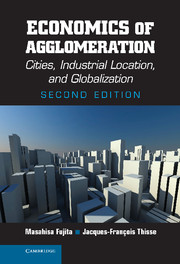Book contents
- Frontmatter
- Dedication
- Contents
- Acknowledgments
- Preface to the Second Edition
- 1 Agglomeration and Economic Theory
- Part I Fundamentals of Spatial Economics
- Part II The Structure of Metropolitan Areas
- Part III Factor Mobility and Industrial Location
- Part IV Urban Systems, Regional Growth, and the Multinationalization of Firms
- References
- Author Index
- Subject Index
Preface to the Second Edition
Published online by Cambridge University Press: 05 August 2013
- Frontmatter
- Dedication
- Contents
- Acknowledgments
- Preface to the Second Edition
- 1 Agglomeration and Economic Theory
- Part I Fundamentals of Spatial Economics
- Part II The Structure of Metropolitan Areas
- Part III Factor Mobility and Industrial Location
- Part IV Urban Systems, Regional Growth, and the Multinationalization of Firms
- References
- Author Index
- Subject Index
Summary
Ever since we completed the first edition of this book, the fields of economic geography and urban economics have grown at a fast pace. The abundance of new and insightful results called for an updating of the first edition. Given this state of affairs, Scott Parris from Cambridge University Press kindly offered us the opportunity to prepare a second edition. The revision is not a minor one. Even though we have chosen to keep the same general organization of the book, all chapters have been rewritten, admittedly to various extents. As a consequence, by reflecting the rapid evolution of the discipline, our book is more comprehensive. However, we want to stress the fact that a large number of recent contributions keep relying on a few basic principles that are sometimes lost in long and sophisticated econometric developments.
Understanding these principles is necessary for our discipline to progress. They also make us realize that seemingly different issues are just the same ones operating at different spatial scales. Although links with empirical works are stressed in many places, the emphasis of the book is still on spatial economic theory. In what follows, we restrict ourselves to highlighting the main changes made in the second edition.
Although a good deal of the material devoted to the Fundamentals of Spatial Economics (Part I) has kept its relevance, the corresponding four chapters involve a fair amount of new material.
- Type
- Chapter
- Information
- Economics of AgglomerationCities, Industrial Location, and Globalization, pp. xiii - xivPublisher: Cambridge University PressPrint publication year: 2013

